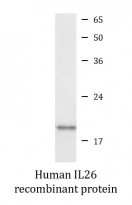ARG70070
Human IL26 recombinant protein (Active) (His-tagged, C-ter)
Human IL26 recombinant protein (Active) (His-tagged, C-ter) for SDS-PAGE
Overview
| Product Description | E. coli expressed, His-tagged (C-ter) Active Human IL26 recombinant protein |
|---|---|
| Tested Application | SDS-PAGE |
| Target Name | IL26 |
| Species | Human |
| A.A. Sequence | Lys22 - Gln171 |
| Expression System | E. coli |
| Activity | Active |
| Activity Note | Determined by its ability to induce IL-10 secretion in COLO205 cells. The ED50 for this effect is <150 ng/mL. |
| Alternate Names | AK155; Protein AK155; IL-26; Interleukin-26 |
Properties
| Form | Powder |
|---|---|
| Purification Note | Endotoxin level is <0.1 EU/µg of the protein, as determined by the LAL test. |
| Purity | >98% (by SDS-PAGE) |
| Buffer | PBS (pH 8.0) |
| Reconstitution | It is recommended to reconstitute the lyophilized protein in sterile water to a concentration not <200 μg/mL and incubate the stock solution for at least 20 min at room temperature to make sure the protein is dissolved completely. |
| Storage Instruction | For long term, lyophilized protein should be stored at -20°C or -80°C. After reconstitution, aliquot and store at -20°C or -80°C for up to one month. Storage in frost free freezers is not recommended. Avoid repeated freeze/thaw cycles. Suggest spin the vial prior to opening. |
| Note | For laboratory research only, not for drug, diagnostic or other use. |
Bioinformation
| Gene Symbol | IL26 |
|---|---|
| Gene Full Name | interleukin 26 |
| Background | This gene was identified by its overexpression specifically in herpesvirus samimiri-transformed T cells. The encoded protein is a member of the IL10 family of cytokines. It is a secreted protein and may function as a homodimer. This protein is thought to contribute to the transformed phenotype of T cells after infection by herpesvirus samimiri. [provided by RefSeq, Jul 2008] |
| Function | May play a role in local mechanisms of mucosal immunity and seems to have a proinflammatory function. May play a role in inflammatory bowel disease. Activates STAT1 and STAT3, MAPK1/3 (ERK1/2), JUN and AKT. Induces expression of SOCS3, TNF-alpha and IL-8, secretion of IL-8 and IL-10 and surface expression of ICAM1. Decreases proliferation of intestinal epithelial cells. Is inhibited by heparin. [UniProt] |
| Cellular Localization | Secreted. [UniProt] |
Images (1) Click the Picture to Zoom In






